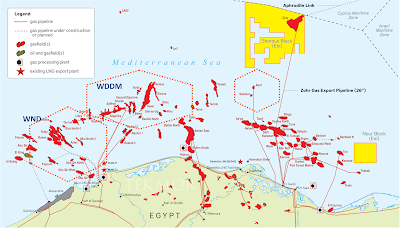Nermina Kulovic
Through BP’s joint venture, Pharaonic Petroleum Company (PhPC), the Qattameya field has been developed through a one-well subsea development and tie-back to existing infrastructure.
Announcing the production start-up, BP said on Monday that the field is expected to produce up to 50 million cubic feet of gas per day.
The Qattameya discovery was announced in March 2017. It is located approximately 45 km west of the Ha’py platform.
It is tied back to the Ha’py and Tuart field development via a new 50km pipeline and is also connected to their existing subsea utilities via a 50 kilometre umbilical.
Karim Alaa, BP’s North Africa regional president, said: “By building on BP’s significant existing assets and infrastructure offshore Egypt, we were able to develop Qattameya efficiently and economically. Creating value through high quality, efficient oil and gas developments is a key part of bp’s strategy. We see this as a great example of resilient hydrocarbons development.
“We are proud to have brought this project safely onstream through an extremely challenging period. Our team continues to work to support Egypt realising the potential of its energy resources, adding to our track-record of delivery and enabled by our established partnerships with the Egyptian petroleum sector”.
BP holds a 100 per cent equity in the North Damietta offshore concession in the East Nile Delta.
Gas production from the field is directed to Egypt’s national grid.
It is worth mentioning that the Qattameya Shallow-1 exploration well was drilled to a total depth of 1,961 metres in a water depth of approximately 108 metres using the El Qaher II jack-up rig.
The wireline logs, pressure data and fluid samples confirmed the presence of 37 metres of net gas pay in high-quality Pliocene sandstones.
SOURCE
Through BP’s joint venture, Pharaonic Petroleum Company (PhPC), the Qattameya field has been developed through a one-well subsea development and tie-back to existing infrastructure.
Announcing the production start-up, BP said on Monday that the field is expected to produce up to 50 million cubic feet of gas per day.
The Qattameya discovery was announced in March 2017. It is located approximately 45 km west of the Ha’py platform.
It is tied back to the Ha’py and Tuart field development via a new 50km pipeline and is also connected to their existing subsea utilities via a 50 kilometre umbilical.
Karim Alaa, BP’s North Africa regional president, said: “By building on BP’s significant existing assets and infrastructure offshore Egypt, we were able to develop Qattameya efficiently and economically. Creating value through high quality, efficient oil and gas developments is a key part of bp’s strategy. We see this as a great example of resilient hydrocarbons development.
“We are proud to have brought this project safely onstream through an extremely challenging period. Our team continues to work to support Egypt realising the potential of its energy resources, adding to our track-record of delivery and enabled by our established partnerships with the Egyptian petroleum sector”.
BP holds a 100 per cent equity in the North Damietta offshore concession in the East Nile Delta.
Gas production from the field is directed to Egypt’s national grid.
It is worth mentioning that the Qattameya Shallow-1 exploration well was drilled to a total depth of 1,961 metres in a water depth of approximately 108 metres using the El Qaher II jack-up rig.
The wireline logs, pressure data and fluid samples confirmed the presence of 37 metres of net gas pay in high-quality Pliocene sandstones.
SOURCE
